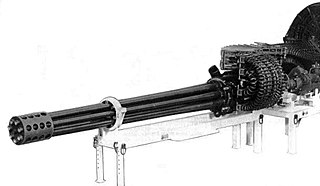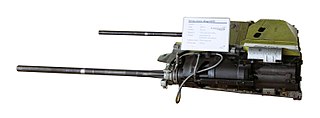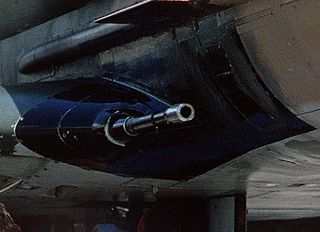
The M61 Vulcan is a hydraulically, electrically, or pneumatically driven, six-barrel, air-cooled, electrically fired Gatling-style rotary cannon which fires 20 mm × 102 mm rounds at an extremely high rate. The M61 and its derivatives have been the principal cannon armament of United States military fixed-wing aircraft for over sixty years.

The 8.8 cm KwK 43 was an 88 mm 71 calibre length tank gun designed by Krupp and used by the German Wehrmacht during the Second World War. It was mounted as the primary armament on the Panzerkampfwagen VI Ausf. B Tiger II. The 8.8 cm Pak 43, an anti-tank gun, was very similar in design but mounted on tank destroyers or deployed stand-alone on the field.

The BK 27 is a 27 mm (1.063 in) caliber revolver cannon manufactured by Mauser of Germany. It was developed in the late 1960s for the MRCA program that ultimately became the Panavia Tornado.

The Maschinengewehr (MG) 151 is a low caliber, belt fed autocannon for aircraft use, developed in Nazi Germany from 1934 to 1940 and produced by Waffenfabrik Mauser during World War II. It was originally produced in 15.1 mm caliber from 1940, with a 15×96mm cartridge, but due to demand for higher effect against aircraft, especially with the introduction of mine shells for the 20 mm MG-FF/M aircraft cannon, the design was rechambered to 20 mm caliber in 1941, using a newly developed 20×82mm cartridge which traded projectile velocity for explosive power. The initial 15 mm variant then became known as the MG 151/15, with the new 20 mm variant becoming the MG 151/20.

The General Electric GAU-8/A Avenger is a 30 mm hydraulically driven seven-barrel Gatling-style autocannon that is primarily mounted in the United States Air Force's Fairchild Republic A-10 Thunderbolt II. Designed to destroy a wide variety of ground targets, the Avenger delivers very powerful rounds at a high rate of fire. The GAU-8/A is also used in the Goalkeeper CIWS ship weapon system, which provides defense against short-range threats such as highly maneuverable missiles, aircraft, and fast-maneuvering surface vessels. The GAU-8/A is produced by General Dynamics.

The General Dynamics GAU-12/U Equalizer is a five-barrel 25 mm Gatling-type rotary cannon. The GAU-12/U is used by the United States, Italy and Spain, which mount the weapon in their attack jets such as the AV-8B Harrier II, airborne gunships such as the Lockheed AC-130, and land-based fighting vehicles. A lighter four-barrel version, designated GAU-22/A, is mounted on F-35 Lightning II fighter jets.

The Nudelman N-37 was a 37 mm (1.46 in) aircraft autocannon used by the Soviet Union. It was designed during World War II by V. Ya. Nemenov of A.E. Nudelman's OKB-16 to replace the earlier Nudelman-Suranov NS-37 and entered service in 1946. It was 30% lighter than its predecessor at the cost of a 23% lower muzzle velocity.

A revolver cannon is a type of autocannon, commonly used as an aircraft gun. It uses a cylinder with multiple chambers, similar to those of a revolver handgun, to speed up the loading-firing-ejection cycle. Some examples are also power-driven, to further speed the loading process. Unlike a rotary cannon, a revolver cannon only has a single barrel, so its spun weight is lower. Automatic revolver cannons have been produced by many different manufacturers.

The Royal Small Arms Factory ADEN cannon is a 30 mm revolver cannon used on many military aircraft, particularly those of the British Royal Air Force and Fleet Air Arm. Developed post-World War II primarily to meet British Air Ministry's requirement for increased lethality in aircraft armament, the cannon was fired electrically and is fully automatic once it is loaded.

The DEFA cannon is a family of widely used French-made aircraft revolver cannon firing 30 mm caliber NATO standard rounds.

The M39 cannon is a 20 mm caliber single-barreled revolver cannon developed for the United States Air Force in the late 1940s. It was used on a number of fighter aircraft from the early 1950s through the 1980s.

The Colt Mk 12 is a 20 mm autocannon that was widely used by the United States Navy after World War II.

The HS.404 is an autocannon originally designed by and produced by the Swiss arm of the Spanish/Swiss company Hispano-Suiza in the mid-1930s. Production was later moved to the French arm of Hispano-Suiza.

The MG FF was a drum-fed, blowback-operated, 20 mm aircraft autocannon, developed in 1936 by Ikaria Werke Berlin of Germany. It was a derivative of the Swiss Oerlikon FF F cannon, with the Oerlikon FF design itself a development of the Imperial German World War I Becker 20 mm cannon, and was designed to be used in space-limited, fixed mountings such as inside aircraft wings, although it saw use as both an offensive and a defensive weapon, in both fixed and flexible format. It saw widespread use in those roles by the German Luftwaffe, particularly during the early stages of World War II, although from 1941 onwards it was gradually replaced by the Mauser firm's 20 mm MG 151/20, which had both a higher rate of fire and muzzle velocity.
The Mauser MG 213 was a 20 mm aircraft-mounted revolver cannon developed for the Luftwaffe during World War II. A further development using a 30 mm round was developed as the MG 213C, alternately known as the MK 213. Neither design was put into service before the war ended.
The Rheinmetall-Borsig MK 103 was a German 30 mm caliber autocannon that was mounted in German combat aircraft during World War II. Intended to be a dual purpose weapon for anti-tank and air-to-air fighting, it was developed from the MK 101. Compared to the MK 101 it was faster firing, and was originally intended to develop a higher muzzle velocity than the MK 101. Unlike the MK 101, the MK 103 used a belt feed, allowing it to potentially carry a larger ammunition load. The MK 103 used electrically primed rather than percussion-primed ammunition. The operating mechanism differed from the recoil-operated MK 101 in that it used a combination of gas and recoil operation. After firing, gas pressure served to unlock the breech, while barrel recoil was used to cycle the action.

Armour-piercing fin-stabilized discarding sabot (APFSDS), long dart penetrator, or simply dart ammunition is a type of kinetic energy penetrator ammunition used to attack modern vehicle armour. As an armament for main battle tanks, it succeeds Armour-Piercing Discarding Sabot (APDS) ammunition, which is still used in small or medium caliber weapon systems.

A mine shell or high-explosive, high-capacity (HEHC) in British military nomenclature, is a military explosive shell type characterized by thin shell walls and a correspondingly high quantity of explosives, much higher than the traditional high explosive shell type per caliber, meaning that mine shells trade fragmentation effect for a higher pressure wave effect when comparing to traditional high explosive shells.

The Gryazev-Shipunov GSh-30-1 is a 30 mm autocannon designed for use on Soviet and later Russian military aircraft, entering service in the early 1980s. Its current manufacturer is the Russian company JSC Izhmash. The name GSH-30-1 is formed from the surnames of the designers Gryazev (Грязев) and Shipunov (Шипунов), the caliber of 30 mm and the single-barrel design of the gun itself.
The 33mm APX was a series of 33 mm caliber autocannon manufactured in France during the early 1930s for use in aircraft.

















